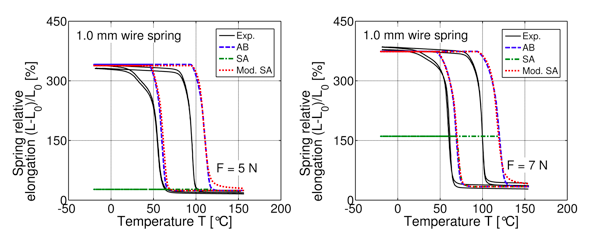- May 20, 2019
- Posted by: info
- Categories: Advanced Materials, Research
Introduction
Shape-memory alloys (SMAs), belonging to the class of smart materials, are exploited in a variety of interesting applications. Solid-phase transformations, induced either by stress or temperature, are behind the remarkable functional properties of SMAs, promoting the concept of innovative smart actuators. SMA helicoidal springs are devices that combine an actuator, a sensor (typically a temperature sensor), and a displacement amplifier. A single component is indeed a system able to accomplish complex functions, as reacting to a temperature variation with an actuation. Despite the apparent simplicity, the behavior of SMA helicoidal springs is rather complex due to SMA thermo-mechanical properties. Consequently, the development process of such devices is a difficult task and their design may possibly take advantage of numerical simulations. An ongoing research [P1] is focusing on the investigation of SMA helicoidal spring actuator behavior, by combining the results of an experimental campaign conducted in SAES Getters with a thorough understanding of SMA experimental behavior and the selection of appropriate constitutive models [R1, P2-P5].
Methods
Experimental data are obtained by a campaign on both SMA straight wires and helicoidal springs that experienced the same annealing process and presenting different geometries. The method consists in the calibration of constitutive model parameters on some experimental results related to SMA wires (see Figure 1).

Results
The calibrated models are then used to predict experimental data on helicoidal springs with different geometries (see Figure 2).

Main collaborations
- SAES Getters
References
- [R1] A.C. Souza, E.N. Mamiya, N. Zouain. Three-Dimensional Model for Solids Undergoing Stress-Induced Phase Transformations, Eur. J. Mech. A: Solids, 1998, 17, p 789–806.
Group publications
- [P1] F. Auricchio, G. Scalet, M. Urbano. A Numerical/Experimental Study of Nitinol Actuator Springs. Journal of Materials Engineering and Performance, 1-9. doi 10.1007/s11665-014-0883-1, 2014.
- [P2] F. Auricchio, L. Petrini. A Three-Dimensional Model Describing Stress-Temperature Induced Solid Phase Transformations: Solution Algorithm and Boundary Value Problems, Int. J. Numer. Meth. Eng., 6, p 807–836, 2004.
- [P3] F. Auricchio, A.Coda, A.Reali, M.Urbano. SMA Numerical Modeling Versus Experimental Results: Parameter Identification and Model Prediction Capabilities, J. Mater. Eng. Perform., 18, p 649–654, 2009.
- [P4] F. Auricchio, E. Bonetti. A New Flexible 3D Macroscopic Model for Shape Memory Alloys, Discret. Contin. Dyn. Syst. Ser. S, 6, p 277–291, 2013.
- [P5] F. Auricchio, E. Bonetti, G. Scalet, F. Ubertini. Refined shape memory alloys model taking into account martensite reorientation. CD-ROM Proceedings of the 6th European Congress on Computational Methods in Applied Sciences and Engineering (ECCOMAS 2012), J. Eberhardsteiner, H.J. Bhm, F.G. Rammerstorfer (Eds), September 10–14, 2012, Wien, Austria, Vienna University of Technology, Austria, 3349–3362, 2012.

